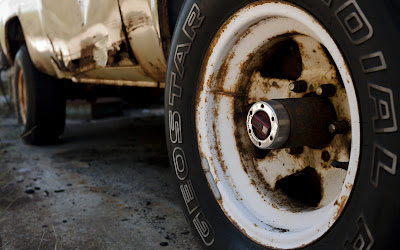Pentax is releasing what will be, as far as I know, far and away the cheapest medium format digital camera on the market. It's a complete camera, meaning no separate back and body assembly, so pop on a lens and you're good to go. At $10,000, it's half the price of the next cheapest medium format cameras from Phase One and Mamiya, which ring in at $20k. While this prevents you from swapping out backs, when the whole camera only costs this much, who cares?
I'm surprised to see SD cards being used for storage. When photo files can easily hit 100MB, where's the CompactFlash?! Other than that, all of the limitations and advantages common to medium format apply. This is very exciting for someone looking to either expand their studio or an enthusiast who wants to take their art to the next level. The price is still quite high, and buying this over a Nikon D3x or Canon EOS 1Ds/5D is something that's going to have to be mulled over. But if you like portrait photography and/or, as Pentax discusses in the interview, landscapes, this camera is just drool-inducing.
My skills are still nowhere near maxing my EOS 5D, but if yours are, what the hell. Go for it.
DPReview posts sample images!:
LinkDPReview, the bestest camera site on the net, has posted sample pictures of the new 645 and even in their studio setting, the detail capture by it in comparison to every other camera they have is amazing. In a studio, it's pixel-peeping. The big differences will be revealed in complex nature and landscape shots, but even here, the difference is significant. For example, look at the small globe.
Obviously, noise levels are still far behind the DSLR's from Cankontaxony, but at only ten grand, and the Sony Alpha A850 now below $2,000, the new flagships from the likes of Canon and Nikon will have to stump up some serious performance to justify their likely-to-be over $7,000 prices.
Early Preview/Review with sample photosJapanese site Digital Camera Watch has posted
a review of the 645D along with multiple full-resolution sample photos. Dynamic range is .5 stops lower than most other medium format cameras at 11.5, but the images are still great. Without a direct comparison, I see no difference between these sample photos and samples available from Mamiya, Phase One, and Hasselblad.
As with many (all?) medium format cameras, the Pentax has no low-pass filter. On such large, high-res sensors this rarely results in moire, and even the complex city scene I was only able to spot the smallest amounts. I did find one of their photos with a noticeable degree, and that was on some rough wood. I've posted the crop below.
Interview and PhotosLuminous Landscape has
an interview with a Pentax rep and a few photos. As with all Luminous Landscape posts, he doesn't provide anything at full resolution, thus rendering all of his photos useless. I don't get this. It's a behavior common along many photo websites. Fuck you. Give me the files.
DxO Mark Releases Test ResultsDxO Mark, whose test methodology befuddles me, has released
sensor information on the 645D. It's not at the top of its class, but it it definitely earns magna. It's beaten out by two Phase One backs and the Nikon D3X, but that's it! The Nikon is half the resolution but brings many other benefits to the table, it also costs a few grand less, and the two Phase One backs cost well over twice as much as the Pentax. Go Pentax!
Ken Rockwell Hates the 645DAs any good critic, it's not their job to explain why something is
good or
bad, but to say whether they liked something or not and to effectively explain why. Ken Rockwell does
an excellent job with this.
Basically, he's arguing that Pentax is retarded for making a medium format camera aimed at the hobbyists who buy point-'n-shoots. Pentax has loaded the camera up with useless features that, if anything, get in the way of the pro shooter. He's also upset that this is not a true medium format camera. The sensor is too small. This criticism is truly damning since the value proposition of the Pentax is predicated on being a direct competitor to more expensive medium format cameras while being only slightly more expensive than Canon and Nikon's top-pro cameras.
I appreciate all of his criticisms, and understand them quite well, I'm still leaning towards liking the camera. Its sensor is larger than Canon and Nikon, has 40MP regardless of sensor size, good dynamic range, and is an excellent introduction to the 645 world. And for only $10k, I'd learn to work around its faults.
Luminous Landscape Full Review:They like it!
They really like it! If anyone was going to kvetch about the 654D it was the Luminous Landscape guys, and they like it enough to call it a "defining camera." Obviously, the price is amazing, but also the ergonomics of the camera were called "stellar."
Luminous Landscape Comparison:After their review, they've posted
a comparison of the 645D and the PhaseOne P40+, they also threw in a Canon EOS 1Ds Mark III and a Leica M9 for good measure. The Canon Performs very poorly, but I think that is a combination of both the lens and the camera. They suspect something might have been wrong. The Pentax performs almost identically to the P40+, even outperforming it at times, but is beaten in the dynamic range competition, but not by much. This means that Pentax was actually telling the complete truth when they said that their dynamic range would slightly trail its competitors.
They're very impressed by the Leica M9's resolution, which was undoubtedly helped by its total lack of a low-pass filter, but admit that for larger prints, you want to move up to the medium format camera. This was an epic comparison and a frank analysis that I'm not used to seeing on photography websites.


















































